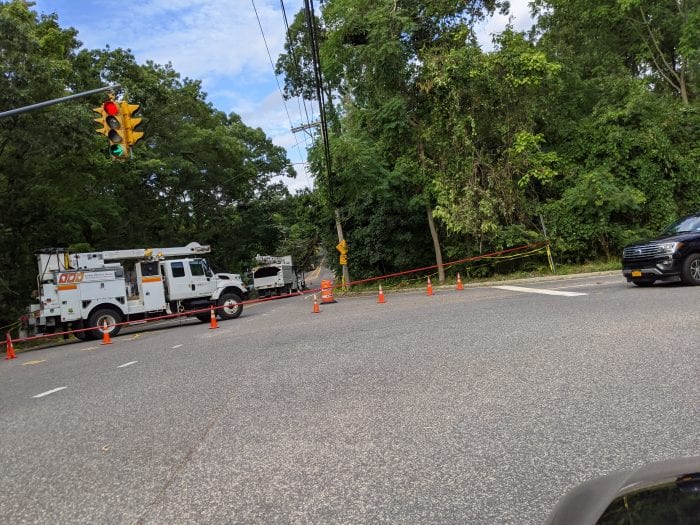LIPA Sues PSEG for $70 Million for Failed Isaias Response

LIPA filed a $70 million lawsuit against PSEG-Long Island in State Supreme Court in Mineola against the New Jersey-based power company for breach of contract in response to Tropical Storm Isaias, which hit Aug. 4 and knocked out power for some Long Islanders for over eight days.
The Department of Public Service recommended a lawsuit to the LIPA Board of Trustees.
“Utility companies are beholden to ratepayers, and when that service is inadequate — or as in this case, a complete failure — those utilities need to be held accountable,” Governor Andrew Cuomo (D) said in a statement. PSEG “failed to hold up their end. It’s inexcusable, and we’re going to make sure that it doesn’t happen again.”
The complaint, filed by attorneys at the law firm Rivkin Radler, alleges breach of covenant of good faith and fair dealing, based on PSEG’s “failure to prepare for and manage restoration effort during and following Tropical Storm Isaias. LIPA also brings this action for specific performance to compel PSEG LI to comply with its obligations” under the operations service agreement.
The suit also alleges “corporate mismanagement, misfeasance, incompetence, and indifference, rising well beyond the level of simple negligence.”
“It’s about time LIPA start acting to protect the best interests of Long Island ratepayers,” Gaughran said in a statement. Gaughran urged LIPA to make sure the $70 million is paid by PSEG shareholders and not ratepayers.
“An independent receiver should be appointed to refund this $70 million to hardworking Long Islanders and not dumped into the blackhole of LIPA’s budget,” Gaughran added.
In a statement, LIPA CEO Tom Falcone said PSEG LI must “immediately fix these failed information technology systems and abide by its contract” as LIPA continues to review its legal, contractual and termination options.
“PSEG Long Island has collected nearly half a billion dollars from Long Island customers over the past seven years while failing to meet its basic obligations,” Falcone added.
John Rhodes, Special Counsel for statewide ratepayer protection for the New York State Department of Public Service, asked if LIPA should “find a new service provider?”
In a statement, PSEG Long Island said it was “hard at work addressing recommendations in LIPA’s 30- and 90-day reports. We believe that the current public-private partnership is the best option for Long Island customers and we have remained committed to being the service provider of choice for LIPA.”
PSEG LI is “aware that this lawsuit has been filed and we are reviewing it.”
Lawsuit Claims
In the lawsuit, LIPA describes PSEG LI as demonstrating willful, bad faith and grossly negligent failures.
One of a litany of complaints during and after the storm was the inability for customers to connect with PSEG and to receive a reliable estimate of the time to restore power.
Ratepayers were “left without critical information as adequate telephone lines were overwhelmed with calls and an Outage Management System, selected by PSEG LI as able to withstand a major storm and paid for by LIPA, failed.”
About a million customer calls and 300,000 text messages did not reach PSEG LI, according to the suit.
Calls to outage and billing lines “became overloaded and failed,” the suit alleges, with 75% of customer calls to PSEG LI’s Outage Line not going through on the first day of the storm.
PSEG LI “did not properly monitor whether the calls on the Outage Line were connecting. Calls were dropped without PSEG LI’s knowledge,” according to the suit.
LIPA asserted that PSEG should have known about the inadequacy of the voice telephony system.
PSEG did not perform sufficient tests to determine whether the system would function during a major storm event before or in the 100 days after Isaias, the suit further claimed.
The problems with the telecommunications system predated the storm, as the suit indicated that the “OMS did not crash due to Isaias. It was already failing.”






